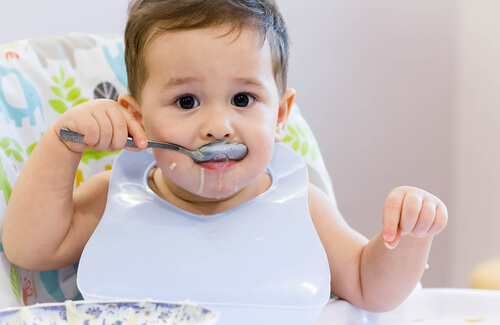5 Tips to Teach Children to Eat Alone

Teaching children to eat alone gives parents more time to carry out everyday tasks. It also means that all family members can eat at the same time.
For this to be possible, you need to be present when your child learns to feed himself.
The most important thing is that you pay special attention to cutting the food into very small pieces to avoid choking. In addition, praising the child’s efforts will encourage him to keep trying.
Certainly, between 12 and 15 months, depending on the evolution of motor skills, children can hold the spoon and take it to their mouths. At that time, it’s possible that the child takes his first giant steps in this transition.
At two years old, normally, children can also start using a fork. We recommend you leave the challenge of cutting the food with a knife until later. Using a knife can be dangerous and must be done under supervision at all times.
5 Tips to Teach Children to Eat Alone
To get the little one to eat alone, it is necessary to follow some strategies. Here are a few tips that we recommend:
1. Offer Foods They Can Eat with Their Hands
The first step for children to learn to feed themselves is through food they can eat with their hands. These should be cut into small pieces that are easy to chew and swallow. They should be foods that can easily dissolve in the mouth.
When the child is older and already knows how to grab things with their hands, it may be the best moment to introduce some silverware. To make it possible, the goal is to cut the food into small pieces and give him a plastic fork.

There are some easy-to-digest foods for the little one. They can be pieces of ripe fruit such as banana, mango or peach, cooked soft vegetables, such as carrots, or pasta and pieces of cheese.
2. Prepare Their Favorite Dish
If you notice that your children have difficulty eating without your help, it may work to prepare their favorite dish. Certainly, it will be much easier for them to feed themselves when they have food in front of them that catches their attention.
Given this situation, the dish will motivate them enough to pick up their fork and eat without the help of parents or other family members.
3. Eat Next to the Little One
The best way for children to learn is through observing adults. Therefore, family meals represent an excellent opportunity for children to learn to feed themselves. In this way, children can repeat and imitate the movements of others while enjoying the company of everyone.
In fact, it’s much more advisable to sit in front of the child and observe him while trying to eat alone. Having a positive attitude will make young children more self-confident and, therefore, learn to eat alone faster.
“Between 12 and 15 months, depending on the evolution of motor skills, children can hold the spoon and take it to their mouths. At two years old, normally, they can also start using a fork.”
4. Involve the Whole Family
From the psychological point of view, for the child to eat without your help, you should make him see that eating is an activity that older siblings and adults do. You’ll see how, in this way, the little one will soon begin to eat alone.
All family members should be involved in this process. Likewise, no one should go back and finish feeding the child.

5. Prepare for Disaster
To teach children to eat alone, you have to prepare for disaster. It’s possible that, while learning, they will dirty the table and end up staining their clothes.
To avoid this, we recommend you put a bib over them, which will minimize the mess. Surely there will be some stains, but putting protective covers and bibs on children will make cleanup a little bit easier.
In short, remember to give your children a lot of encouragement along the way, be patient and praise all of their successes. We recommend creating a pleasant environment around the meals by introducing a simple little routine.
Teaching children to eat alone gives parents more time to carry out everyday tasks. It also means that all family members can eat at the same time.
For this to be possible, you need to be present when your child learns to feed himself.
The most important thing is that you pay special attention to cutting the food into very small pieces to avoid choking. In addition, praising the child’s efforts will encourage him to keep trying.
Certainly, between 12 and 15 months, depending on the evolution of motor skills, children can hold the spoon and take it to their mouths. At that time, it’s possible that the child takes his first giant steps in this transition.
At two years old, normally, children can also start using a fork. We recommend you leave the challenge of cutting the food with a knife until later. Using a knife can be dangerous and must be done under supervision at all times.
5 Tips to Teach Children to Eat Alone
To get the little one to eat alone, it is necessary to follow some strategies. Here are a few tips that we recommend:
1. Offer Foods They Can Eat with Their Hands
The first step for children to learn to feed themselves is through food they can eat with their hands. These should be cut into small pieces that are easy to chew and swallow. They should be foods that can easily dissolve in the mouth.
When the child is older and already knows how to grab things with their hands, it may be the best moment to introduce some silverware. To make it possible, the goal is to cut the food into small pieces and give him a plastic fork.

There are some easy-to-digest foods for the little one. They can be pieces of ripe fruit such as banana, mango or peach, cooked soft vegetables, such as carrots, or pasta and pieces of cheese.
2. Prepare Their Favorite Dish
If you notice that your children have difficulty eating without your help, it may work to prepare their favorite dish. Certainly, it will be much easier for them to feed themselves when they have food in front of them that catches their attention.
Given this situation, the dish will motivate them enough to pick up their fork and eat without the help of parents or other family members.
3. Eat Next to the Little One
The best way for children to learn is through observing adults. Therefore, family meals represent an excellent opportunity for children to learn to feed themselves. In this way, children can repeat and imitate the movements of others while enjoying the company of everyone.
In fact, it’s much more advisable to sit in front of the child and observe him while trying to eat alone. Having a positive attitude will make young children more self-confident and, therefore, learn to eat alone faster.
“Between 12 and 15 months, depending on the evolution of motor skills, children can hold the spoon and take it to their mouths. At two years old, normally, they can also start using a fork.”
4. Involve the Whole Family
From the psychological point of view, for the child to eat without your help, you should make him see that eating is an activity that older siblings and adults do. You’ll see how, in this way, the little one will soon begin to eat alone.
All family members should be involved in this process. Likewise, no one should go back and finish feeding the child.

5. Prepare for Disaster
To teach children to eat alone, you have to prepare for disaster. It’s possible that, while learning, they will dirty the table and end up staining their clothes.
To avoid this, we recommend you put a bib over them, which will minimize the mess. Surely there will be some stains, but putting protective covers and bibs on children will make cleanup a little bit easier.
In short, remember to give your children a lot of encouragement along the way, be patient and praise all of their successes. We recommend creating a pleasant environment around the meals by introducing a simple little routine.
This text is provided for informational purposes only and does not replace consultation with a professional. If in doubt, consult your specialist.








